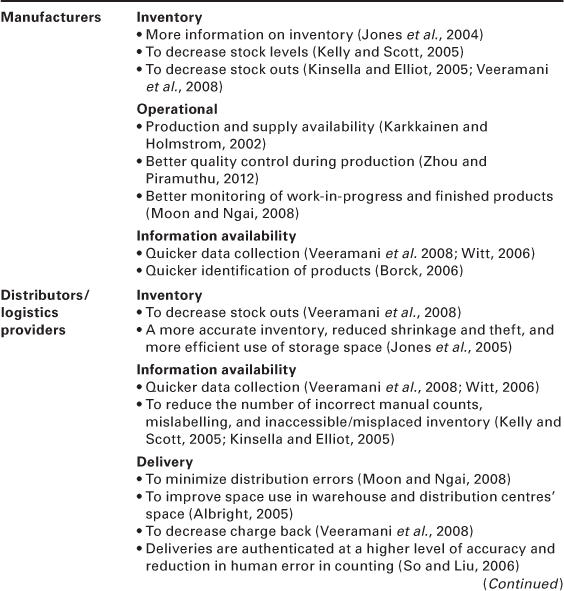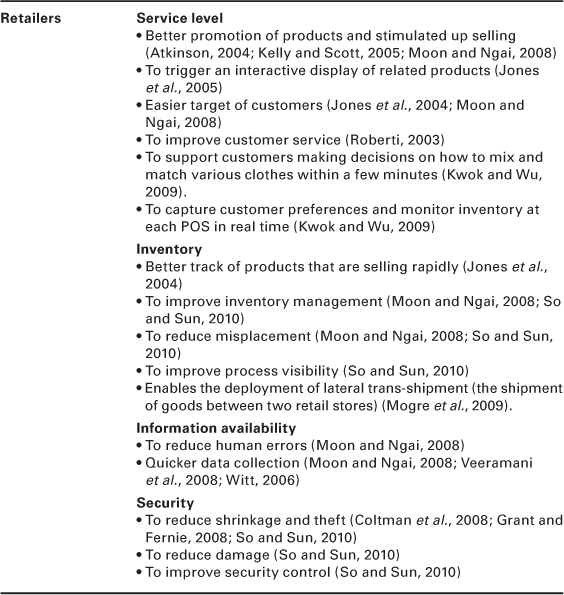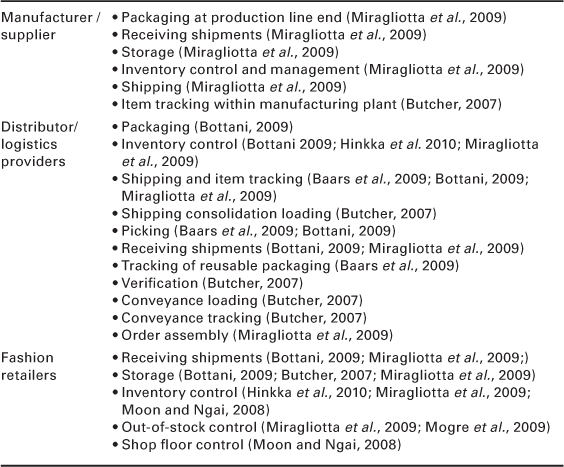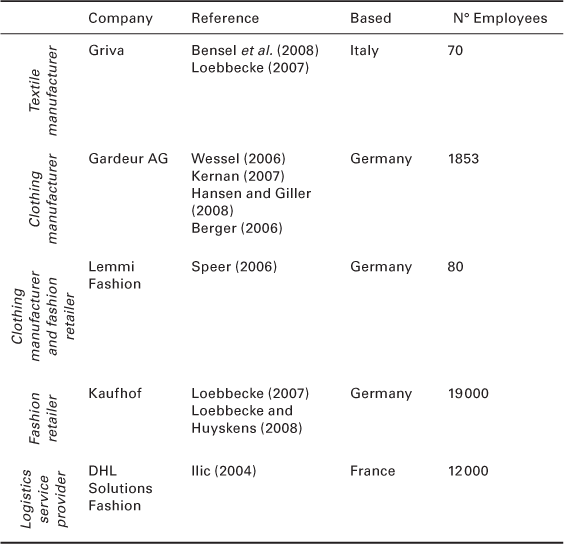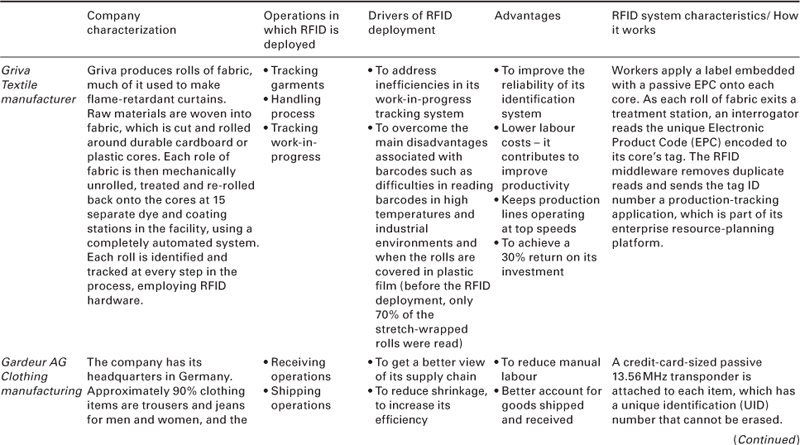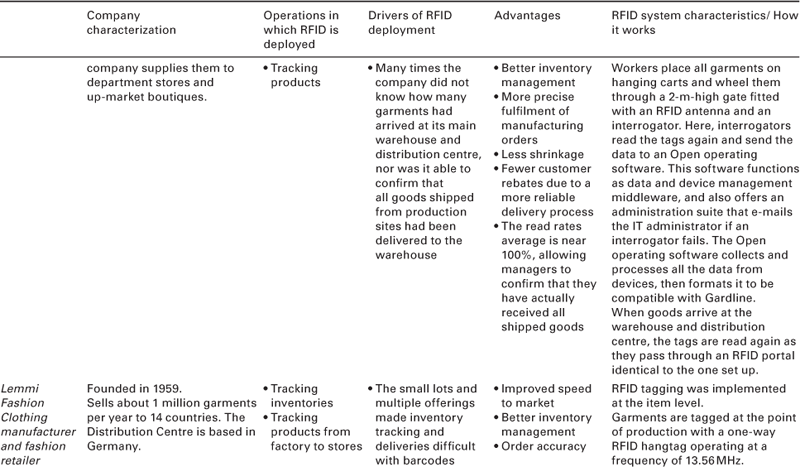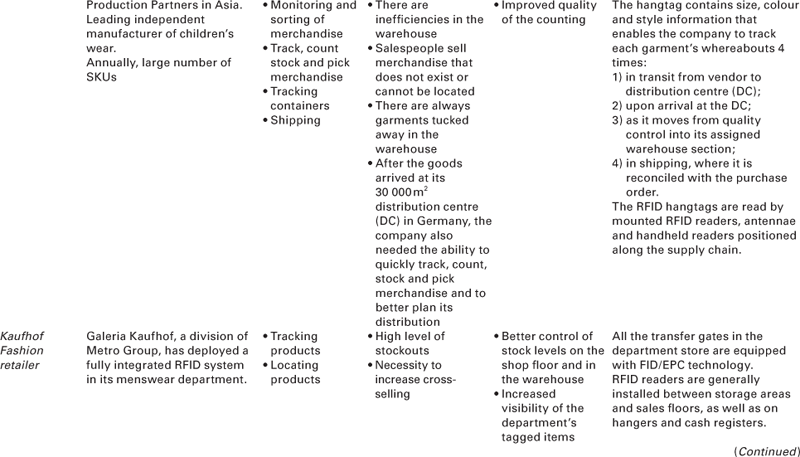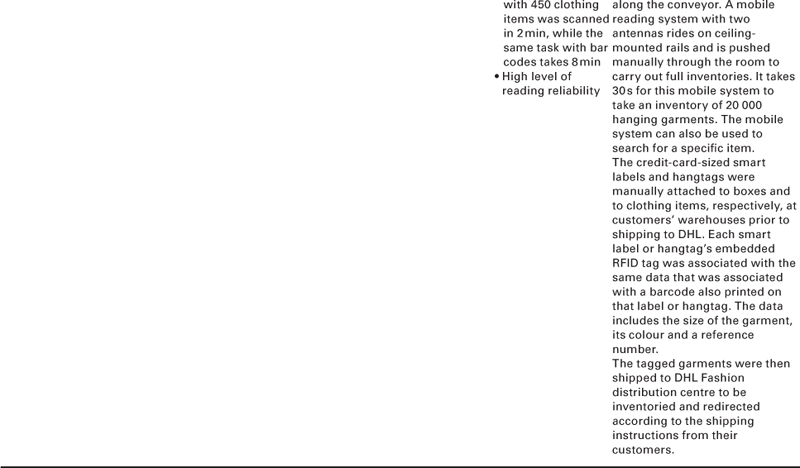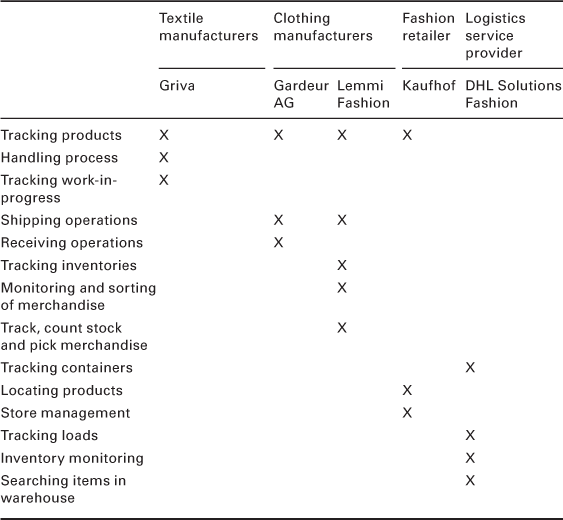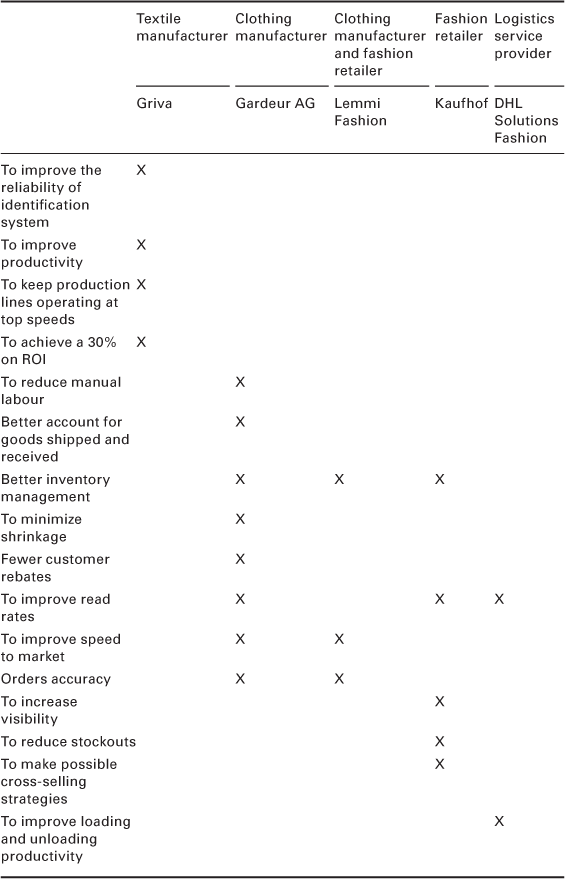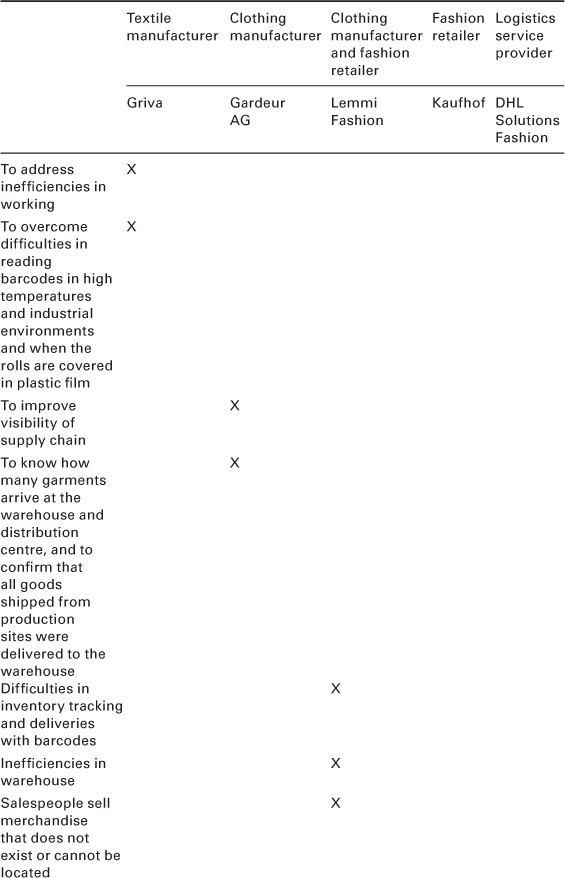The role of radio frequency identification (RFID) technologies in improving process management and product tracking in the textiles and fashion supply chain
S.G. Azevedo, University of Beira Interior, Portugal
P. Prata and P. Fazendeiro, Instituto de Telecomunicações, Portugal
Abstract:
This chapter aims to gain a better understanding of RFID deployment in the Fashion and Textile Supply Chain (FTSC), mainly concerning its application in supporting operations, its advantages and main business drivers. In an attempt to find an RFID deployment pattern within the FTSC, a cross-case analysis was performed. The RFID experience of five companies based in different countries was analysed. From these empirical data, three main conclusions are drawn: (1) RFID is deployed mainly to support the following operations: the handling process; tracking work-in-progress; receiving operations; shipping operations; tracking products; tracking inventories; monitoring and sorting of merchandise; counting stock and picking merchandise; tracking containers; shipping; locating products; and store management. (2) The main advantages highlighted are: better inventory management; improved read rates; and order accuracy. (3) The main driver that led the case study companies to deploy RFID technology was the identification of inefficiencies in several of their operations.
Key words
RFID; fashion and textile supply chain (FTSC); industry operations; business drivers; case study
3.1 Introduction
Radio Frequency Identification (RFID) technology is a wireless identification technology that improves communication of electronic information associated with physical items (Modrak et al., 2010). It is composed of several elements (Atkinson, 2004):
RFID technology is an automatic identification system that uses radio frequency signals for wireless communication (Khan et al., 2009) and was patented in the 1980s by Charles Walton (1983). Its potential for the reduction of inventory losses, increases in efficiency and speed of processes, and the improvement of information accuracy (Sarac et al., 2010), makes it an important tool for organizations and supply chains in sustaining their competitive advantage (Erickson and Kelly, 2007; Mehrjerdi, 2010; Visich et al., 2009). Indeed, RFID has become an important source of competitive advantage by increasing supply chain transparency through the dissemination of large amounts of accurate and real-time data to enhance decision-making processes.
The value of RFID technology is particularly visible in Fashion and Textile Supply Chains (FTSCs), as the fashion business is characterized by a wide assortment of products, short life-cycles, high seasonality, high volatility, high-impulse purchasing and complicated distribution and logistics operations (Castelli and Brun, 2010; Christopher et al., 2004). This FTSC business model puts significant emphasis on rapid delivery, high-quality products and low prices for each supply chain segment. In this highly competitive environment, the availability of a certain product category (or a specific item) is a relevant source of value to customers, and hence there are huge penalties associated with the current season’s ‘must-have’ advertised items being out of stock (Brun and Castelli, 2008). To respond to customer needs, ‘time compression’ and flexibility should be developed into the whole supply chain, beginning with the textile product itself. Castelli and Brun (2010) also stress the need to align operations of different FTSC members along the supply chain, enhancing information exchange through the use of new communication tools and process coordination practices. As stated by Lo et al. (2008), building an integrated supply chain management information system to combine information and share knowledge of the entire supply chain is an important task to improve the efficiency and effectiveness of its management.
This technology is now at a stage where there are potentially larger advantages from a wider range of applications but barriers still remain. Despite numerous studies on the advantages of RFID technology for several supply chain operations, Lee and Ozer (2007) observe that a large gap exists between the perception and reality of what is generally assumed to be the benefits engendered by RFID deployment. According to Kapoor et al. (2009), there is a lack of in-depth studies considering the drawbacks of RFID implementation in a supply chain management context. In addition, Sarac et al. (2010) stress the need to conduct research for multiple items and multiple actors in order to provide more realistic analyses of supply chains.
In this chapter, a cross-case analysis is performed applying investigator triangulation (Jick, 1979) to gain a better understanding of RFID deployment in the FTSC. The focus is mainly on its application in supporting companies’ operations, and on the advantages and drivers for adoption of the technology. The remainder of this chapter is organized as follows. The general application context of RFID technology in a supply chain is presented. This is followed by a discussion of its enhanced application to FTSC operations, along with the derivation of a set of working propositions. In order to assert the validity of such propositions, a cross-case analysis is then presented, with a description of the methodology employed and a presentation of the case studies analysed. The main conclusions of the study are drawn in the final section of the chapter.
3.2 Using RFID in supply chains: an overview
The widespread use of RFID in supply chain management only started in the last decade, when a number of world leading retailers (including the Metro Group in Germany, Marks & Spencer in the UK and Wal-Mart in the USA) mandated the use of RFID for tracking supplies (Cover Pages, 2003; Roberti, 2003). According to a study from the RFID Research Center at the University of Arkansas (Cromhout et al., 2012), in the first stage of RFID usage (2003–2006), the focus was to identify pallets and cases moving from distribution centres to retail stores. In the second stage (2006–2009), the focus shifted to individual items in store. Finally, in 2010, the main conclusion was that RFID should be used in the entire supply chain from point of manufacture to store shelf.
In 2010, the Voluntary Interindustry Commerce Solutions (VICS) association launched the Item Level RFID Initiative, with the purpose of establishing a course of action for electronic product code (EPC) adoption throughout the retail supply chain (ILRI, 2010). EPC-enabled RFID technology was designed to allow the unique identification of every single instance of each item manufactured, as opposed to just the manufacturer and class of products, as barcodes usually do.
The moment to incorporate the concepts of full supply-chain visibility into business philosophy is when RFID technology is already stable and its widespread use has led to a drastic reduction in the price of hardware and software (Javick, 2011). In Ustundag (2013), RFID is presented as a key strategic technology that adds value throughout the supply chain by increasing process efficiency, accuracy, visibility and security. This means that RFID investment should be seen as a strategic business decision and not as a technological choice.
In the last few years, there have been high levels of investment in the development and improvement of RFID systems, because of the important advantages that companies and supply chains can achieve in their operations management, when compared to barcodes (Chang et al., 2010). These advantages derive mainly from innovations in identification operations, and then from the reduction or even elimination of the manual work required to scan items.
This system also has a high capacity, whilst being simultaneously rigorous (So and Liu, 2006), which could become an important source of competitive advantage and innovation in the operations management field. These characteristics contribute to increasing the efficiency of a range of operations such as materials displacement, for example, since warehouse operators do not have to manipulate an optical reader to collect data about the products that are being loaded or unloaded. Moreover, this new technology allows the collection of information from objects on the move (Knill, 2002), enhancing the visibility of material flows and allowing better coordination between supply chain entities (Chang et al., 2010).
RFID also allows the tracking of every single article along the FTSC. A unique EPC identifier can be written into the tag applied to each article, and the specific product features, along with supply chain information, can be associated with each identifier in a firm’s information system (Mogre et al., 2009). To Gaukler and Seifert (2007), the main advantages resulting from RFID deployment in supply chains operations management can be categorized into labour and time savings and also in the benefits from increased visibility. According to Mogre et al. (2009), this visibility enables new replenishment policies such as lateral trans-shipment, as with the shipment of goods between two retail stores in order to reduce stock outages, inventories and transportation costs. Sarac et al. (2010) analysed the advantages of RFID in overcoming inventory inaccuracy, the bullwhip effect and replenishment policies; these and other advantages are identified in Table 3.1.
3.3 The use of RFID technology in fashion and textile supply chains (FTSC)
Firms in the textile and fashion industry have been regarded as late adopters of innovative technologies, lagging far behind firms in other sectors such as the automotive, healthcare and electronics industries (Moon and Ngai, 2008). Short product life-cycle, long production lead time and high forecasting errors are critical problems found in this specific supply chain (Lam and Postle, 2006). Bruce et al. (2004) identified low profit margins for domestic suppliers, slow responsiveness to a competitive market place and high product variety as additional problems.
The FTSC involves raw material suppliers, textile manufacturers, clothing manufacturers, retailers and, finally, consumers. This kind of supply chain deploys a pull strategy, using all data on consumer behaviour as strategic information (Fig. 3.1). The Fashion and Textile industry is characterized by labour-intensive and multi-faceted processes with relative technological simplicity (Azuma et al., 2009). The goals of supply chain management in this kind of industry are delivering the textile and fashion trends at the right time in the right place, with increased variety, affordability and customization, thus satisfying both existing and potential customer needs (Azuma et al., 2009). To maintain competitiveness in the global market, manufacturers need to both shorten the lead time of new products and increase their responsiveness to market changes, using approaches and tools to automate their logistics operations and improve their access to information (Bottani, 2009).
Bruce et al. (2004) argue that keeping low product inventories, adopting technology to manage product replenishment and delivery processes, sourcing overseas and manufacturing domestically could all save costs, reduce lead times and provide quick responses to customer demands. Fashion products constantly change and induce companies in the FTSC to introduce internal changes; So and Sun (2010) suggest that applying the lean services used in apparel retail operations across the board may equally benefit FTSC companies. The use of RFID technology may have a significant impact on every link along the supply chain (Chen and Pfleuger, 2008; Melski et al., 2007).
The deployment of RFID in the FTSC helps ensure more efficient supply chain processes (Gaukler and Seifert, 2007; Loebbecke, 2004), providing higher transparency throughout the supply chain from textile manufacturers to fashion retail stores (Chappell et al., 2003b), as well as new options for advertising inside stores (Chappell et al., 2003a). Hinkka et al. (2010) discuss the FTSC characteristics that make it appropriate for RFID utilization: product variety is high and the different products are difficult to separate at first sight. Another issue in FTSC is the different needs of each supply chain member. Fashion retailers face the challenge of adapting quickly and frequently to keep up with product changes and demand trends, to meet customer needs (Bottani, 2009). In this regard, the ability of the RFID to track and trace items can streamline many operations along the supply chain. However, Hinkka et al. (2010) argue that RFID solutions are mainly designed for retail purposes, even though the same tags could be used upstream in the supply chain.
Gaukler and Seifert (2007) argue that assembly and manufacturing operations could benefit from the advantages associated with RFID: tags could be used in a manufacturing setting to identify the product that is being produced, allowing savings in labour and reworking costs. If tags are attached early in the manufacturing phase, other supply chain members could also exploit them, increasing supply chain visibility and potentially reducing handling errors and confusion. RFID advantages could also be realized in shipment handling, as well as in picking and packing processes (Bensel et al., 2008). Gaukler and Seifert (2007) also discuss the usefulness of RFID in logistics activities across a supply chain, namely in reducing bottlenecks, enabling a faster and less costly product movement, and improving inventory accuracy.
In retailing, improvements in on-shelf availability of goods can be achieved by redesigning the shelf replenishment process, creating transparency within the actual inventory in store and, in this way, improving inventory control (Bensel et al., 2008). Moon and Ngai (2008) suggested that the use of RFID technology in retail can streamline stocktaking operations, strengthen customer relationships, facilitate promotional activities and allow retailers to allocate resources more effectively. Table 3.2 illustrates RFID deployment to support different operations across a supply chain.
This overview suggests the following proposition:
The increased deployment of RFID technology in the FTSC is motivated essentially by the following advantages that companies can expect to achieve: increasing sales, improved efficiency, better flexibility, improvements in forecasting and planning, error reduction, traceability, workflow improvement, lead time reduction, internal inventory control, production status, improved shelf management, enhancement of customer service, responsiveness, reduction in the time spent counting, cost savings, reduction in shrinkage, increased visibility, labour reduction, and a shorter order-to-cash cycle. Many of these advantages are related to inventory measures (Jones et al., 2005; Kinsella and Elliot, 2005; Veeramani et al., 2008).
The RFID literature suggests a second proposition:
P2: Most of the RFID advantages recognized by companies in the FTSC are related to inventory management.
In Roussos (2008), a set of business drivers for implementing RFID technology for supply chain optimization is identified:
• Handling efficiency: resulting mainly from the fact that RFID allows the automatic identification of product and containers without the need of a line-of-sight between the reader and tag, unlike with barcodes.
• Out-of-stock reduction: RFID can increase product availability by reducing the number of delivery errors and by increasing inventory accuracy in all stages of the supply chain.
• Inventory reduction: the use of RFID may increase the accuracy and timeliness of demand forecasts.
• Order reconciliation: this technology can prevent delivery errors, facilitate delivery confirmation and can be a means of proof for shipment delivery.
• Theft prevention: RFID at the item level works as an anti-theft system. RFID may also be useful in preventing the introduction of counterfeit trade throughout the supply chain.
Moreover, according to Charikleia (2010), the main forces that drive retailing companies to use RFID technology are:
• The need for total visibility: RFID can give visibility throughout the supply chain and thus minimize products or supplies shortages.
• Increased information sharing: RFID can increase collaboration between the different departments within a company, as well as between supply chain partners.
• Increased coordination: RFID can enable successful coordination between members of a supply chain, in terms of strategies and decision-making.
• Increased competition: companies need to keep up with new technologies and concepts to face market conditions and RFID is considered as a good solution to improve supply chain efficiency.
• Increased customer awareness and demands: today’s customers have high demands and expectations and RFID can enable the full control of each individual product.
• Technology trigger: the wide advertising of RFID technology and extensive research in the area make it an attractive option for a large number of companies.
• The continuously growing need for cost reduction: RFID appears to be an attractive solution to optimize every business process, achieving lower costs and increasing efficiency throughout the supply chain.
There are some specific drivers promoting adhesion to RFID downstream of the FTSC, where inventory is constantly on the move – between shelves, the dressing room and the backroom – unlike in other retail segments where items have a set location on the rack. The study presented in Waller et al. (2011) identifies a set of potential use cases where drivers to the implementation of RFID can be identified:
• Store operations: improving backroom-to-shelf replacement and improving perpetual inventory accuracy are the processes that can have the most benefits for apparel manufactures (Delen et al., 2007; Gaukler and Seifert, 2007; Hardgrave et al., 2008).
• Demand signals: the main driver is to improve the accuracy of order forecasts (Williams and Waller, 2010, 2011).
• Inventory management: the main drivers for using RFID are related to the reduction of both cycle and safety stock.
• Distribution centre (DC) operations: RFID tags can be used to improve cycle counting in speed and accuracy and can also have a positive impact on pick/pack operations.
• Inbound and outbound processes: item-level RFID tagging offers the ability to audit the content of each carton through an automated scan process, reducing the time and labour in inbound and outbound processes.
• Tracking and traceability shipping: RFID tracking and tracing enable quality management and continuous quality improvement.
In recent years, the use of RFID technology has also been seen as suitable for identifying and preventing counterfeiting in the fashion supply chain. In Miragliotta et al. (2010) and Amato et al. (2012), models to evaluate how RFID technologies can help to prevent product counterfeiting and grey markets are presented.
As can be seen by this literature review, many of the drivers suggested for deployment of RFID technology by companies are associated with inefficiencies in many different operational processes. This suggests the following third proposition:
3.4 Using RFID technology in practice: the use of case studies
The main objective of this research is to investigate RFID technology deployment in the FTSC in order to identify the main operations supported by it, and also look at the advantages and drivers associated with it. As there is sometimes a gap between management research and practice (Markides, 2007; Shapiro et al., 2007), a case study approach was selected in an attempt to fill this gap. According to Ellram (1996), case studies are the best means to understanding a certain phenomenon, as they provide depth and richness, allowing the researcher to really understand the what, how and why questions pertaining to a given situation. From both Perry’s (1998) and Rowley’s (2002) points of view, a case-study approach is adequate when the boundaries of a phenomenon are not only unclear but there is also no control over behavioural events, as in this case. Attacking the same problem with a variety of methods from a variety of angles can be useful, not only for the study itself, but also for the validity of the analysis. If the same phenomenon is observed with more than one method it will, most probably, increase the authenticity of the observation.
Bearing in mind this advice, in this research, RFID deployment in FTSC is explored from the point of view of RFID users (textile manufacturers, clothing manufacturer, logistics providers and retailers). According to Oppermann (2000), using a team of diverse researchers may help to reduce any eventual bias and, with this in mind, this research team was composed of three researchers: two experts in computer science and engineering, and one in management and logistics. Furthermore, using multiple data sources may lead to discoveries that would not have been made otherwise. To this end a triangulation approach can be used, combining multiple approaches to ‘zero in’ on the answers to a research question (Singleton and Straits, 1999). This can involve combining multiple data sources (data triangulation), using multiple research methods to analyze the same problem (methodological triangulation), or using multiple investigators to work on the same task (investigator triangulation) (Jick, 1979; Oppermann, 2000). In this chapter, data and investigator triangulations were used, as explained below. Triangulation allows the researcher to address a broader range of issues, including historical, attitudinal and behavioural factors (Yin, 2002).
The case-study method has three distinct stages: design, collection and analysis. The final stage is an analysis of the individual case studies, allowing ‘cross-case’ reports to be written (Yin, 2002). In general, the search for patterns can be conducted using internal or cross-case analyses. When using more than one case in a study, it is logical to find similarities and differences across the cases using various cross-case analysis tools. Among others, this practice can help to identify critical predictor variables and causal interactions, and to validate or extend existing theoretical models (Stuart et al., 1998). Thus, pattern-matching is rightly characterized as a form of empirical validation for qualitative data (Johnston et al., 1999).
To reach this chapter’s objectives, five illustrative case studies were conducted based on secondary data using external sources, namely books, journals, business magazines and websites. Despite being limited to the selected case studies and to the available data in external sources, this research design helps to define issues specifically before a primary study, such as an in-depth case study, is undertaken. The primary data will support the validity of the propositions. To this end, the case studies were analyzed as a means to:
• identify the main operations supported by RFID, the advantages and drivers most referred to by companies positioned at different FTSC levels; and
• to obtain a deeper knowledge of the way different partners deal with RFID, i.e. which operations, advantages and drivers are identified by them.
Using a methodology similar to Finch (2004), McKinnon (2006) and Visich et al. (2009), the secondary data for this research study were gathered from the analysis of published literature based on a broad range of sources including newspapers, conference proceedings, industry reports, White Papers, press releases and books. In addition, some specialized magazines on RFID, such as RFID Journal and Logistics Today, were used. To take part in this research, RFID companies had to:
The selected articles describing case studies were analyzed and, finally, individual aspects are briefly described with a special focus on operations supported, and the advantages and drivers of RFID technology deployment in FTSC. The objective was not to offer further insight into the single case studies, but to bring them together to get a wider picture and learn from the cross-case analysis (Seuring, 2004).
3.5 Case studies in the use of RFID technology: background and results
A set of illustrative case studies, consisting of five international companies belonging to different nodes of the supply chain, were analyzed to illustrate RFID deployment in the FTSC. Each of the companies’ experience with the RFID system was explored to identify the operations where RFID is most deployed, the main advantages reached with RFID implementation, and the main drivers that motivate its deployment. The objective was to give answers to the propositions formulated in the previous section and to reach a deeper knowledge on the deployment of RFID in the FTSC. In order to uncover contextual issues, exploratory case studies were developed (Yin, 2002). Data was gathered from newspapers, conference proceedings, industrial reports, White Papers, press releases and books and also some journals and magazines on the topic. This section is organized as follows: first, the sample profile is presented; second, individual case analyses are developed to identify the main operations supported by RFID, and the main advantages and drivers that motivate the case study companies to deploy RFID.
3.5.1 Summary of the case studies
The case studies used were: one textile manufacturer (Griva); one clothing manufacturer (Gardeur AG); one clothing and fashion retailer (Lemmi Fashion); one fashion retailer (Kaufhof); and one logistics service provider (DHL Solutions Fashion). Company profiles, locations and company sizes are presented in Table 3.3, whilst the operations in which RFID were deployed, the main drivers to RFID utilization and the main advantages reached with it, are described for each individual company in Table 3.4.
As can be seen in Table 3.3, the case studies are taken from several countries: Italy, Germany, and also France. This allows a wider comparison and a better understanding of RFID deployment in FTSC within different realities to be made. Moreover, most of the companies are large, with up to 1800 employees.
3.5.2 RFID technology deployment in FTSC operations
In the world of textile and fashion retailing, the start-up process of a collection assumes, more and more, a strategic role in the competitiveness of a company. When the number of items of apparel begin to increase, it is critical that companies adopt new management paradigms in order to make their processes more agile, thus avoiding not only delays in the reception of items in warehouses, but also bottlenecks in the launching phase of a collection. This is possible through the deployment of RFID technology, which allows the synchronization of supply chain members.
In the companies researched, RFID technology has been deployed in different ways and contexts supporting different kind of operations (Table 3.5). Some of the operations supported include: handling processes; tracking of work-in-progress; receiving operations; shipping operations; tracking products; tracking inventories; monitoring and sorting of merchandise; the tracking, counting of stock and picking of merchandise, tracking containers and shipping; locating products; and store management.
All the case studies deploy RFID to support several operations, with ‘tracking products operations’ being the most used, followed by ‘shipping operations’.
According to the analysis of the five companies, it is possible to infer that companies in the FTSC deploy RFID to support different operations. Therefore, the results support the following proposition:
3.5.3 Advantages of RFID technology in FTSC operations
Many advantages associated with the deployment of RFID technology were recognized by the case study companies, with the three recognized by almost all the companies being ‘better inventory management’, ‘improvement of read rates’ and ‘orders’ accuracy’ (Table 3.6).
Better inventory management was indicated by the clothing manufacturer, Gardeur AG, the clothing manufacturer and fashion retailer, Lemmi Fashion and by the fashion retailer, Kaufhof. Improvement of read rates was identified by the clothing manufacturer, Gardeur AG, the fashion retailer, Kaufhof and also the logistics service provider, DHL Solutions Fashion. Orders’ accuracy was identified as an important advantage of RFID deployment by the clothing manufacturer, Gardeur AG and the clothing manufacturer and fashion retailer, Lemmi Fashion. The evidence from Table 3.6 thus supports the second proposition:
3.5.4 Main drivers of RFID technology in FTSC operations
The implementation of RFID technology in the case studies results from the necessity of the companies to overcome identified internal problems and inefficiencies. As can be seen from Table 3.7, each company points out different drivers to the implementation of RFID technology. The main reason for this is that the companies belong to different segments of the FTSC, and thus have different working conditions and face different problems. One driver, though meaning different things to different companies, is common to all: the ‘identification of inefficiencies’ associated with the development of different operations. For example, inefficiencies are identified as an important driver in the factory, Griva, in warehouses, Lemmi Fashion, in stores, Lemmi Fashion, on the shop floor, Kaufhof, and in the delivery of products, Kaufhof.
Another driver is related to drawbacks associated with barcodes, such as difficulties in inventory tracking and deliveries, Lemmi Fashion, and the difficulty of reading in high temperatures and industrial environment, Griva. Finally, another driver that motivates the deployment of RFID technology among the case study companies is the necessity of accurate counting of products, Gardeur AG and Lemmi Fashion. Thus, the results from Table 3.7 support the third proposition:
3.6 Conclusion
The increased use of RFID technology has been highlighted by several kinds of companies, especially within the fashion and textile world, as a positive factor because of the advantages it brings. The fashion and textile industry has unique requirements associated with short product life-cycle, long production lead time, and high forecasting errors which have motivated companies to deploy RFID. The case studies in this chapter have shown that companies in the FTSC deploy RFID technology to support operations. This clearly supports proposition P1, with some of the operations supported by this technology and identified by the case study companies being the handling process, tracking work-in-progress, receiving operations, shipping operations, tracking products, tracking inventories, monitoring and sorting of merchandise, counting stock and picking merchandise, tracking containers, locating products, and store management. This result is in line with the literature review (Baars et al., 2009; Bottani, 2009; Butcher, 2007; Miragliotta et al., 2009).
When companies deploy RFID technology they expect to achieve some advantages, usually associated directly with the overcoming of inefficiencies previously identified in the way some operations are performed. The main advantages highlighted by the companies researched are better inventory management, improved read rates and order accuracy. Within these advantages, inventory management is the one recognized by three of the five companies researched. These results make it possible to infer that proposition P2 is observed in this study, enforcing the same conclusions gathered in the literature review (Jones et al., 2005; Kinsella and Elliot, 2005; Veeramani et al., 2008).
Finally, the main driver that led the case study companies to deploy RFID technology is the identification of inefficiencies in several operations. This same result can be found in Charikleia (2010), Roussos (2008) and Waller et al. (2011). Based on this, it can be stated that the proposition P3 is observed.
This study makes several interesting contributions, from both an academic and managerial perspective. First, it is an empirical investigation of the deployment of RFID technology in FTSC, examining different companies at different SC levels and in different geographical realities. Second, the state-of-the-art of RFID deployment among FTSC companies is explored from the point of view of RFID users, strengthening the validity of the analysis. Moreover, the case-study examination of the main operations supported by RFID technology, its advantages and the main drivers to its introduction form a third important contribution for companies in this industry. However, the limitations of the study should be noted: further research concerning RFID deployment in the FTSC is needed, with more case studies, or a survey to consider a wide sample from around the world. Future researchers should collect large samples of empirical data from the FTSC to enable a deeper analysis of RFID deployment in these kinds of supply chains.
3.7 Acknowledgement
This work was partly supported by Fundação para a Ciência e Tecnologia (FCT) under the project PEst-0E/EEI/LA0008/2013.
3.8 References
1. Albright B. Retailers wrestle with the data end of RFID. Frontline Solutions. 2005;6(5):8–23.
2. Amato I, Papadimitriou T, Baglieri E. The anti-counterfeiting potential of RFID technologies in the fashion supply chain. In: 17th International Working Seminar on Production Economics, Innsbruck, Austria. 2012.
3. Atkinson W. Tagged: the risks and rewards of RFID technology. Risk Management. 2004;51(7):12–18.
4. Azuma NJ, Fernie J, Higashi T. Market orientation and supply chain management in the fashion industry. In: Fernie J, Sparks L, eds. Logistics and Retail Management: Emerging Issues and New Challenges in the Retail Supply Chain. London, PA: Kogan Page Ltd.; 2009:62–81.
5. Baars H, Gille D, Strüker J. Evaluation of RFID applications for logistics: a framework for identifying, forecasting and assessing benefits. European Journal of Information Systems. 2009;18(6):578–591.
6. Bensel P, Gunther O, Tribowski C, Vogeler S. Cost-benefit sharing in cross-company RFID applications: A case study approach. In: ICIS 2008 Proceedings, 29th International Conference on Information Systems, Paris, 1–17. 2008; Available from: aisel.aisnet.org/icis2008/129/; 2008; (accessed 13 February 2013).
7. Berger D. RFID-Roll-Out beim Bekleidungshersteller Gardeur AG. In: 2006:20–21. ident. 4.
8. Borck J. Tuning in to RFID. InfoWorld. 2006;28(16):31–36.
9. Bottani E. The impact of RFID technology on logistics processes of the fashion industry supply chain. International Journal of RF Technologies: Research and Applications. 2009;1(4):225–252.
10. Bruce M, Daly L, Towers N. Lean or agile: A solution for supply chain management in the textiles and clothing industry. International Journal of Operations & Production Management. 2004;23(2):151–170.
11. Brun A, Castelli C. Supply chain strategy in the fashion industry: Developing a portfolio model depending on product, retail channel and brand. International Journal of Production Economics. 2008;116(2):169–181.
12. Butcher T. Radio Frequency Identification: An enabler of agile supply chain decision-making. International Journal of Agile Systems and Management. 2007;2:305–320.
13. Castelli CM, Brun A. Alignment of retail channels in the fashion supply chain: An empirical study of Italian fashion retailers. International Journal of Retail and Distribution Management. 2010;38(1):24–44.
14. Chang S, Klabjan D, Vossen T. Optimal radio frequency identification deployment in a supply chain network. International Journal of Production Economics. 2010;125(1):71–83.
15. Chappell G, Durdan D, Gilbert G, Ginsberg L, Smith J, Tobolski J. Auto-ID in the Box: The Value of Auto-ID Technology in Retail Stores Accenture White Paper 2003a.
16. Chappell G, Durdan D, Gilbert G, Ginsberg L, Smith J, Tobolski J. Auto-ID on Delivery: The Value of Auto-ID Technology in the Retail Supply Chain Accenture White Paper 2003b.
17. Charikleia L. RFID in the Retailing Supply Chain: A Case Study on a Fashion Retailing Industry. MSc thesis. Available from: hdl.handle.net/2077/22606; 2010; (accessed 10 February 2013).
18. Chen JV, Pfleuger Jr P. RFID in retail: A framework for examining consumers’ ethical perceptions. International Journal of Mobile Communications. 2008;6(1):53–66.
19. Christopher M, Lowson R, Peck H. Creating agile supply chains in the fashion industry. International Journal of Retail and Distribution Management. 2004;32(8):367–376.
20. Coltman T, Gadh R, Michael K. RFID and supply chain management: introduction to the special issue. Journal of Theoretical and Applied Electronic Commerce Research. 2008;3(1):3–5.
21. Cover Pages. METRO group to introduce RFID across process chain. Cover Pages Press Release 2003; Available from: xml.coverpages.org/METRO-RFID.html; 2003; (accessed 7 February 2013).
22. Cromhout D, Williams B, Hardgrave B. RFID Item-level Quantity Auditing for Apparel Supplier Distribution Centers University of Arkansas RFID Research Centre 2012.
23. Delen D, Hardgrave B, Sharda R. RFID for better supply-chain management through enhanced information visibility. Production and Operations Management. 2007;16(5):613–624.
24. Ellram LM. The use of the case study method in logistics research. Journal of Business Logistics. 1996;17(2):93–138.
25. Erickson G, Kelly E. Building competitive advantage with radio frequency identification tags. Competitiveness Review. 2007;17(1/2):37–46.
26. Finch P. Supply chain risk management. Supply Chain Management: An International Journal. 2004;9(2):183–196.
27. Gaukler GM, Seifert RW. Applications of RFID in supply chains. In: Jung H, Jeong B, Frank Chen F, eds. Trends in Supply Chain Design and Management: Technologies and Methodologies. London: Springer; 2007:29–48.
28. Grant DB, Fernie J. Exploring out-of-stock and on-shelf-availability in non-grocery, high street retailing. International Journal of Retailing and Distribution Management. 2008;36(8):661–672.
29. Hansen W, Giller F. RFID for the Optimization of Business Processes Cambridge: John Wiley & Sons, Ltd; 2008.
30. Hardgrave B, Langford S, Waller M, Miller R. Measuring the impact of RFID on out of stocks at Wal-Mart. MIS Quarterly Executive. 2008;7(4):181–192.
31. Hinkka V, Rahkonen M, Holmström J, Främling K. Building supply chain wide tracking systems: Case fashion and book supply chains. In: The 16th International Working Seminar on Production Economics. Innsbruck, Austria. 2010; Available from: legacy-tuta.hut.fi/logistics/publications/Innsbruck_2010_SC_wide_tracking.pdf; 2010; (accessed 13 February 2013).
32. Ilic C. Tracking fashion with RFID. RFID Journal 2004; 15 November. Available from: www.rfidjournal.com/article/print/1235; 2004; (accessed 13 February 2013).
33. ILRI. Item Level RFID Initiative 2010; Available from: www.vilri.org; 2010; (accessed 7 February 2013).
34. Javick P. What’s the future of item-level RFID? Apparel, Technology & Business Insight – from concept to consumer 2011; Available from: apparel.edgl.com/case-studies/What-s-the-Future-of-Item-Level-RFID-75851; 2011; (accessed 7 February 2013).
35. Jick TD. Mixing qualitative and quantitative methods: Triangulation in action. Administrative Science Quarterly. 1979;24:602–611.
36. Johnston WJ, Leach MP, Liu AH. Theory testing using case studies in business-to business research. Industrial Marketing Management. 1999;28(3):201–212.
37. Jones P, Clarke-Hill C, Hillier D. The benefits, challenges and impacts of radio frequency identification technology (RFID) for retailers in the UK. Marketing Intelligence & Planning. 2005;23(4):395–403.
38. Jones P, Clarke-Hill C, Hillier D, Comfort D. Radio frequency identification in retailing and privacy and public policy issues. Management Research News. 2004;27(8/9):46–56.
39. Kapoor G, Zhou W, Piramuthu S. Challenges associated with RFID tag implementations in supply chains. European Journal of Information Systems. 2009;18(6):526–533.
40. Karkkainen M, Holmstrom J. Wireless product identification: Enabler for handling efficiency, customisation and information sharing. Supply Chain Management: An International Journal. 2002;7(4):242–252.
41. Kelly E, Scott P. RFID tags: Commercial applications vs privacy rights. Industrial Management & Data Systems. 2005;105(5/6):703–715.
42. Kernan A. Moving to mass markets. Supply Network 2007:39–41.
43. Khan MA, Sharma M, Brahmanandha Prabhu R. A survey of RFID tags. International Journal of Recent Trends in Engineering. 2009;1(4):68–71.
44. Kinsella B, Elliott M. Delivering the goods. Industrial Engineer. 2005;37(3):24–31.
45. Knill B. Pallet tracking leads RFID applications. Material Handling Management. 2002;57(1):8–10.
46. Kwok SK, Wu KKW. RFID-based intra-supply chain in textile industry. Industrial Management & Data Systems. 2009;109(9):1166–1178.
47. Lam JKC, Postle R. Textile and apparel supply chain management in Hong Kong. International Journal of Clothing Science & Technology. 2006;18(4):265–277.
48. Lee H, Ozer O. Unlocking the value of RFID. Production and Operations Management. 2007;16(1):40–64.
49. Lo W, Hong T, Jeng R. A framework of E-SCM multi-agent systems in the fashion industry. International Journal of Production Economics. 2008;114(2):594–614.
50. Loebbecke C. Modernizing retailing worldwide at the point of sale. Management Information Systems Quarterly Executive. 2004;3:177–187.
51. Loebbecke C. Piloting RFID along the supply chain: A case analysis. Electronic Markets. 2007;17:29–38.
52. Loebbecke C, Huyskens C. A competitive perspective on standard-making: Kaufhof’s RFID project in fashion retailing. Electronic Markets. 2008;18(1):30–38.
53. Markides C. In search of ambidextrous professors. Academy of Management Journal. 2007;50(4):762–768.
54. McKinnon A. Life without trucks: The impact of a temporary disruption of road freight transport on a national economy. Journal of Business Logistics. 2006;27(2):227–232.
55. Mehrjerdi Y. Coupling RFID with supply chain to enhance productivity. Business Strategy Series. 2010;11(2):107–123.
56. Melski A, Thoroe L, Caus T, Schumann M. Beyond EPC – Insights from multiple RFID case studies on the storage of additional data on tag. In: International Conference on Wireless Algorithms,Systems and Applications. IEEE Computer Society 2007.
57. Miragliotta G, Pala E, Perego A, Tumino A. RFID technologies to track original products: A general evaluation model and an application to the apparel industry. In: 12th International Conference on The Modern Information Technology in the Innovation Processes of the Industrial Enterprise (MITIP), Aalborg (Denmark). 2010:248–256.
58. Miragliotta G, Perego A, Tumino A. A quantitative model for the introduction of RFID in the fast moving consumer goods supply chain: Are there any profits? International Journal of Operations & Production Management. 2009;29(10):1049–1082.
59. Modrak V, Knuth P, Novak-Marc J. Advantages and risks of RFID in business applications. International Business Management. 2010;4(1):28–34.
60. Mogre R, Perego A, Tumino A. RFID-enabled lateral trans-shipments in the fashion apparel supply chain. In: Proceedings of the 3rd International Workshop on RFID Technology – Concepts, Applications, Challenges, IWRT 2009. conjunction with ICEIS 2009, International Conference on Enterprise Information Systems, Milan. 2009.
61. Moon KL, Ngai EW. The adoption of RFID in fashion retailing: A business value-added framework. Industrial Management & Data Systems. 2008;108(5):596–612.
62. Oppermann M. Triangulation – A methodological discussion. The International Journal of Tourism Research. 2000;2(2):141–146.
63. Perry C. Processes of a case study methodology for postgraduate research in marketing. European Journal of Marketing. 1998;32(9/10):785–802.
64. Roberti M. RFID: the cost of being smart. CIO Insight 2003; 1(30). Available from: www.cioinsight.com/c/a/Past-News/RFID-The-Cost-of-Being-Smart/; 2003; (accessed 7 February 2013).
65. Roussos G. Computing with RFID: Drivers, technology and implications. Advances in Computers. 2008;73:161–217.
66. Rowley J. Using case studies in research. Management Research News. 2002;25(1):16–27.
67. Sarac A, Absi N, Dauzère-Pérès S. A literature review on the impact of RFID technologies on supply chain management. International Journal of Production Economics. 2010;128(1):77–95.
68. Seuring S. Integrated chain management and supply chain management? comparative analysis and illustrative cases. Journal of Cleaner Production. 2004;12(8/10):1059–1071.
69. Shapiro DL, Kirkman BL, Courtney HG. Perceived causes and solutions of the translation problem in management research. Academy of Management Journal. 2007;50(2):249–266.
70. Singleton RA, Straits BC. Approaches to Social Research New York: Oxford University Press; 1999.
71. So S, Liu J. Securing RFID applications: issues, methods, and controls. Information Systems Security. 2006;15(4):43–56.
72. So S, Sun H. Creating ambient intelligent space in downstream apparel supply chain with radio frequency identification technology from lean services perspective. International Journal of Services Sciences. 2010;3(2/3):133–157.
73. Speer JK. Lemmi fashion making (13.56) waves. Apparel Magazine. 2006;47(6):22–24.
74. Stuart I, Deckert P, McCutcheon D, Kunst R. Case study: A leveraged learning network. Sloan Management Review. 1998;39(4):81–93.
75. Ustundag A, ed. The Value of RFID, Benefits vs Costs. London: Springer Verlag; 2013.
76. Veeramani D, Tang J, Gutierrez A. A framework for assessing the value of RFID implementation by Tier-one suppliers to major retailers. Journal of Theoretical and Applied Electronic Commerce Research. 2008;3(1):55–70.
77. Visich JK, Li S, Khumawala BM, Reyes PM. Empirical evidence of RFID impacts on supply chain performance. International Journal of Operations & Production Management. 2009;29(12):1290–1315.
78. Waller MA, Cromhout D, Patton JB. An Empirical Study of Potential Uses of RFID in the Apparel Retail Supply Chain University of Arkansas RFID Research Centre 2011.
79. Walton CA. Portable radio frequency emitting identifier 1983; US patent 4384288, 17 May 1983. Available from: www.google.com/patents?vid=4384288; 1983; (accessed 7 February 2013).
80. Wessel R. Clothing manufacturer invests its ROI in RFID. RFID Journal 2006; Available from: http://www.rf-it-solutions.com/uploads/tx_easydownloadlist/200608_gardeur.pdf; 2006.
81. Williams B, Waller M. Creating order forecasts: Point-of-sale or order history? Journal of Business Logistics. 2010;31(2):231–251.
82. Williams B, Waller M. Estimating a retailer’s base stock level: An optimal distribution centre order forecast policy. Journal of the Operational Research Society. 2011;62(4):662–666.
83. Witt C. Real-world ROI for RFID. Material Handling Management. 2006;61(5):26–31.
84. Yin RK. Case Study Research: Design and Methods. In: 3rd edition Thousand Oaks, CA: Sage Publications, Inc; 2002; Applied Social Research Methods Series. vol. 5.
85. Zhou W, Piramuthu S. Manufacturing with item-level RFID information: From macro- to micro-quality control. International Journal of Production Economics. 2012;135(2):929–938.

